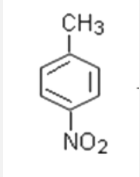In the reaction sequence :- ASnCl2/HCl−−−−−−→BNaNO2/HCl−−−−−−−→0∘CH2O/Δ−−−−→C6H5OH, A,B and C are :-
Benzene, nitrobenzene, aniline
Nitrobenzene, aniline and azo-compound
Nitrobenzene, benzene, amine
None of these
The correct Answer is:B
To solve the given reaction sequence and identify compounds A, B, and C, we will analyze each step of the reaction based on the reagents used.
1. Identify Compound A:
The first reagent used is SnCl₂ in the presence of HCl. This reagent is known for reducing nitro groups to amines. Therefore, we can deduce that Compound A must be a nitro compound. The most common nitro compound in this context is nitrobenzene (C₆H₅NO₂).
- A = Nitrobenzene (C₆H₅NO₂)
2. Identify Compound B:
The reaction of nitrobenzene with SnCl₂ and HCl will reduce the nitro group to an amine group, resulting in the formation of aniline (C₆H₅NH₂).
- B = Aniline (C₆H₅NH₂)
3. Identify Compound C:
The next step involves the reaction of aniline with NaNO₂ and HCl at low temperatures (0°C). This reaction leads to diazotization, forming benzene diazonium chloride (C₆H₅N₂Cl).
- C = Benzene diazonium chloride (C₆H₅N₂Cl)
4. Final Reaction:
The final step involves heating the benzene diazonium chloride in the presence of water. This reaction leads to the hydrolysis of the diazonium salt, resulting in the formation of phenol (C₆H₅OH).
- Final Product = Phenol (C₆H₅OH)
Summary of Compounds:
- A = Nitrobenzene (C₆H₅NO₂)
- B = Aniline (C₆H₅NH₂)
- C = Benzene diazonium chloride (C₆H₅N₂Cl)
The first reagent used is SnCl₂ in the presence of HCl. This reagent is known for reducing nitro groups to amines. Therefore, we can deduce that Compound A must be a nitro compound. The most common nitro compound in this context is nitrobenzene (C₆H₅NO₂).
- A = Nitrobenzene (C₆H₅NO₂)
The reaction of nitrobenzene with SnCl₂ and HCl will reduce the nitro group to an amine group, resulting in the formation of aniline (C₆H₅NH₂).
- B = Aniline (C₆H₅NH₂)
The next step involves the reaction of aniline with NaNO₂ and HCl at low temperatures (0°C). This reaction leads to diazotization, forming benzene diazonium chloride (C₆H₅N₂Cl).
- C = Benzene diazonium chloride (C₆H₅N₂Cl)
The final step involves heating the benzene diazonium chloride in the presence of water. This reaction leads to the hydrolysis of the diazonium salt, resulting in the formation of phenol (C₆H₅OH).
- Final Product = Phenol (C₆H₅OH)
- A = Nitrobenzene (C₆H₅NO₂)
- B = Aniline (C₆H₅NH₂)
- C = Benzene diazonium chloride (C₆H₅N₂Cl)
Topper's Solved these Questions
- ALKENE, ALKANE & ALKYNE BOOK - ALLENCHAPTER - ALKENE, ALKANE & ALKYNE EXERCISE - EXERCISE-2
103 Videos
- ALKENE, ALKANE & ALKYNE BOOK - ALLENCHAPTER - ALKENE, ALKANE & ALKYNE EXERCISE - EXERCISE-3
99 Videos
- ALKENE, ALKANE & ALKYNE BOOK - ALLENCHAPTER - ALKENE, ALKANE & ALKYNE EXERCISE - EXCERSISE-3
28 Videos
- AIIMS 2019BOOK - ALLENCHAPTER - AIIMS 2019EXERCISE - CHEMISTRY
40 Videos
- ALKYL AND ARYL HALIDEBOOK - ALLENCHAPTER - ALKYL AND ARYL HALIDEEXERCISE - EXERCISE-05 (B)
35 Videos
Similar Questions
Knowledge Check
In the given reaction sequence
C6H5NO2Sn/HCl−−−−→ANaNO2+HCl−−−−−−−−→BCuCN/HCN−−−−−−−−→CH2∅H⊕−−−−→ΔD
Which one is not correct ?AA is C6H5NH2BB is C6H5−⊕N≡N−ClCC is C6H5CH2CNDD is C6H5COOH
 (A) overset(NaNO_(2)//HCl)underset((ii)H_(2)//Ni)underset(0-5^(@))(rarr)(B) , is:
(A) overset(NaNO_(2)//HCl)underset((ii)H_(2)//Ni)underset(0-5^(@))(rarr)(B) , is:
View SolutionIn the reaction sequence
C6H5CHONH2OH/H⊕−−−−−−−−→Δ(X)P2O5/Δ−−−−−→(Y)H2O,H+−−−−−→(Z)
(X), (Y) and (Z) respectively be
View SolutionIn the reaction sequence C6H5CHONaCN/HCl−−−−−−−→(X)H2O/H⊕−−−−−→ product, Product will be
View SolutionIn the reaction sequence
CH3−O∣∣C−H−HCN−−−→.ΘOH(A)H2O/⊕H−−−−→Δ Product is/are :
View SolutionIn the reaction sequence CH3−CO−CH3C2H5OH/OH−−−−−−−−−−→(A)C2H5OH/H+−−−−−−−−→[X] will be
View SolutionIn the reaction sequence CH3CHONH2OH/⊕H−−−−−−−→(A)P2O5/Δ−−−−−→(B), B will be
View SolutionWrite the structures of A, B and C in the following :
(i) C6H5−CONH2Br2/aq.KOH−−−−−−−−→ANaNO2+HCl−−−−−−−−→0−5.∘CBKI−−→C
View Solution

